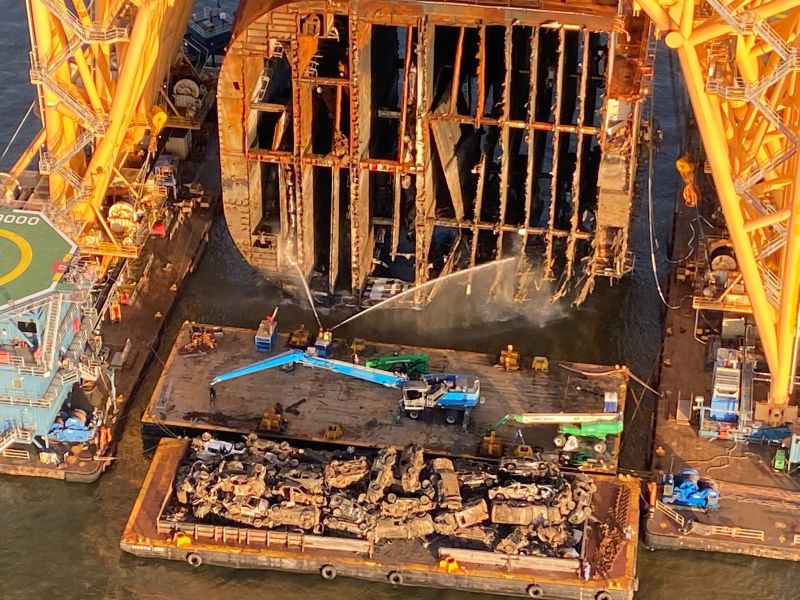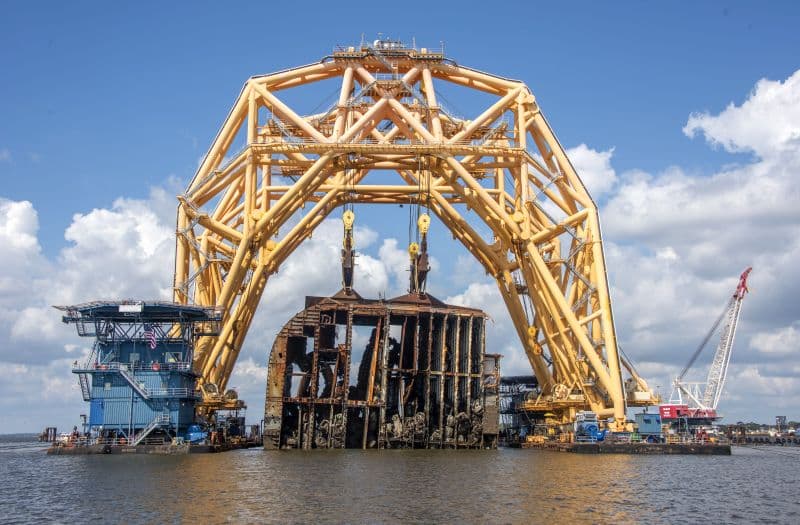
[ad_1]

An official shared the latest update on the Golden Ray wreck removal that was ongoing off the Georgia coast. He said that it is, so far, the largest in the history of the US. The task took up over three million man-hours.
The 656-foot ship was transporting 4,100 vehicles before it suddenly capsized in St. Simons Sound in September ’19. The resulting damage was worth over $200 million. Wreck removal workers removed the final, remaining part of the capsized ship Monday.
The removal was indeed a complicated task. In an update on Tuesday, Commander Efren Lopez said that it involved experts from all over the globe.

The weight-shedding team uses seawater from barge-mounted monitors to flush sediment from the final section of the Golden Ray wreck on Thursday in an effort to further reduce the weight of the section and ensure a safe removal operation. St. Simons Sound Incident response photo.
Lopez proudly added that the team has accomplished a notable feat. Since 2019, they could rescue 23 seamen. Of them, four had been stuck in the engine compartment for more than 30 hours. However, not one of them encountered any life-threatening injuries. The greatest wreck removal activity in US history has also been completed finally.
The National Transportation Safety Board has reported recently that the cause of the cargo ship capsizing was a miscalculation revolving around the ship’s stability.
The NTSB has also discovered that two watertight doors were left open. This had caused the ship to flood when it capsized. The flood trapped four members of the crew who were rescued.
Gallagher Marine Systems’ Response Director, Chris Graff, said that the rescue team navigated extreme weather conditions.
Crews have been able to get rid of over 8,000 pounds of ship debris from the shore as well as water. They have also collected non-ship trash of nearly 9,500 pounds.

The VB-10000 hoists the final section of the Golden Ray wreck, Section Four, slowly out of St. Simons Sound on Saturday. St. Simons Sound Incident response photo.
Graff commented that chances are the marshes and beaches areas clean and pristine as they could have been over several years.
Matt Cook, the Project Manager for TNT Salvage, has said that a mile-long protection barrier that enclosed about 30 acres had been constructed with the goal of minimizing the release of chunks of debris and floating hydrocarbon.
Workers had started disassembling The Golden Ray wreckage last year during February. The salvage operation could remove materials of about 45,000 short tons.
The Emergency Response Manager of the Georgia Department of Natural Resources, John Maddox, has reportedly said that it could take years for St. Simon Sound to be back in its baseline condition. He also added that while the threat resulting from pollution has reduced significantly, it is not eliminated.
On 8 September 2019 at about 1 am, The Golden Ray had departed from the Port of Brunswick, after loading and unloading vehicles. It set sail for Baltimore. When the ship turned to its right, it suddenly heeled to the left, settling at a sharp 90 degrees angle.
Last year during a public hearing, Captain Jonathan Tennant, who had steered the vessel out of the port, has reportedly said that everything had seemed to be normal before it had capsized.
Flooding, saltwater corrosion, and fire meant that the vessel was declared a loss estimated at $62.5 million, a NTSB report mentioned. Cargo worth about $142 million had been lost.
Reference: stsimonssoundincidentresponse.com / Video: USCG Southeast – Facebook
The St. Simons Sound Incident Unified Command is the official source of information for the Golden Ray wreck removal and response operations.
Watch: Largest Wreck Removal In US History Reaches Final Section appeared first on Marine Insight – The Maritime Industry Guide
[ad_2]
This article has been posted as is from Source